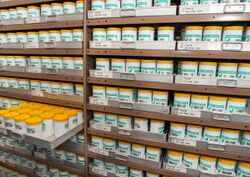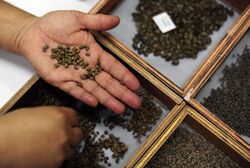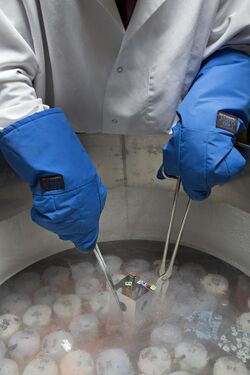Biology:Gene bank
Gene banks are a type of biorepository that preserves genetic material. For plants, this is done by in vitro storage, freezing cuttings from the plant, or stocking the seeds (e.g. in a seedbank). For animals, this is done by the freezing of sperm and eggs in zoological freezers until further need. With corals, fragments are taken and stored in water tanks under controlled conditions.[1] Genetic material in a 'gene bank' is preserved in a variety of ways, such as freezing at -196 °C in liquid nitrogen, being placed in artificial ecosystems, or put in controlled nutrient media.
In plants, it is possible to thaw the material and propagate it. However, in animals, a living female is required for artificial insemination. While it is often difficult to use frozen animal sperm and eggs, there are many examples of it being done successfully.
In an effort to conserve agricultural biodiversity, gene banks are used to store and conserve the plant genetic resources of major crop plants and their crop wild relatives. There are many gene banks all over the world, with the Svalbard Global Seed Vault being considered the most famous one.[2][3]
The database of the largest gene banks in the world can be queried via a common website, Genesys. A number of global gene banks are coordinated by the CGIAR Genebank Platform
Types of gene bank
Seed bank
A seed bank is where seeds of many different species of plants are stored at freezing temperatures so that we have a way of preserving genetic diversity for the future. The temperature depends on how long the seeds are kept frozen. Temperature for short term storage (3–5 years) is between 5 and 10 °C (41 and 50 °F). Temperature for medium term storage (10–15 years) is at 0 °C (32 °F). Temperature for long term storage (50 or more years) is between −18 and −20 °C (0 and −4 °F). Seeds can remain dormant for many years so there is no need to keep restocking. Other parts of a plant that can be stored in these banks are spores and pteridophytes. Tuber crops, a type of seedless plant, cannot be frozen and stored. It is also important that when seeds are stored, they have a constant low moisture content to keep them viable at freezing temperatures. Seeds with a high moisture content will perish.[4] The largest seed bank in the world is the Millennium Seed Bank housed at the Wellcome Trust Millennium Building (WTMB), located in the grounds of Wakehurst Place in West Sussex, near London.[dubious ][5] The world’s largest seed vault is the Svalbard Global Seed Vault. Located in Spitsbergen, Norway , this seed vault was made to preserve genetic diversity in case there would ever be extinction or loss of any and all plants.[3]
In vitro bank
In this technique, buds, protocorm and meristematic cells are preserved through particular light and temperature arrangements in a nutrient medium, which is either a gel or in liquid form. This technique is used to preserve seedless plants and plants that reproduce asexually or that require preservation as clones such as commercial cultivars.[6]
Cryobank
In this technique, a seed or embryo is preserved at very low temperatures. It is usually preserved in liquid nitrogen at -196 °C.[7] By freezing the seeds or embryos at this temperature they can stay viable for at least a century.[4] This is helpful for the conservation of species facing extinction.[7] Cryobanks are utilized for the cryoconservation of animal genetic resources.[8] An example of one of the world’s largest animal cryobanks is the frozen zoo made by the San Diego Zoo, in San Diego California.[9] With animal cryobanks freezing embryos is preferred instead of the separate egg and sperm because the embryos are more resistant to the freezing process.[10]
Storage of pollen
The storage of pollen is where pollen grains are stored through a cryopreservation technique called vitrification. Vitrification is the prosses where pollen grains are frozen but no ice or ice crystals form.[8] The pollen, which is stored in liquid nitrogen, is kept at temperatures of -180 °C to -196 °C. The National Seed Storage Lab in Fort Collins, Colorado currently uses this technique to store pollen.[11] Pollen can also be freeze dried and stored at temperatures of 5 °C to -18 °C.[4] An important element that must be considered is the levels of moisture in the pollen. If the pollen grains have a low moisture content it helps increase the length of the pollen’s life. Low levels of moisture help the pollen freeze without creating ice or ice crystals, which helps preserve the life span of the pollen while it is being stored.[12][13] Ideal levels of moisture content in the pollen depends on the type of plant. The pollen from different plant species can be put into two groups. One is Binucleate pollen, which has a thicker exine and the second is Trinucleate pollen, which has a thinner exine. Binucleate pollen has a higher lifespan when frozen at a low moisture level. Trinucleate pollen, however, has a lower lifespan when frozen at a low moisture level.[12] Some ways that scientists decrease moisture level is to expose the pollen to diluted salt solutions, silica gel, dry air, or treatment with vitrification solutions.[14]
Field gene bank
This is a method of sowing plants for the conservation of genes. For this purpose, an ecosystem is created artificially. Through this method, one can compare the differences among plants of different species and can study them in detail. It needs more land, adequate soil, weather, etc. Germplasm of important crops are conserved through this method. 42,000 varieties of rice are conserved in the Central Rice Research Institute in Orissa.[citation needed][15]
See also
- Sperm bank
- Ova bank
- Biobank
- Biological database
- Germplasm
- Seed bank
- Plant genetic resources
- Multi-Crop Passport Descriptor (MCPD)
References
- ↑ "青汁と口臭とサプリメントと運動". http://www.cdnn.info/eco/e031117/e031117.html.
- ↑ On practical and theoretical differences between a storage and a gene bank, see Nicole C. Karafyllis (ed.): Theorien der Lebendsammlung. Pflanzen, Mikroben und Tiere als Biofakte in Genbanken (in German), Freiburg: Karl Alber 2018 (Lebenswissenschaften im Dialog Vol. 25) ISBN:978-3-495-48975-8
- ↑ 3.0 3.1 Liu, Rita (15 April 2022). "Seed banks: the last line of defense against a threatening global food crisis" (in en-GB). The Guardian. ISSN 0261-3077. https://www.theguardian.com/environment/2022/apr/15/seed-banks-the-last-line-of-defense-against-a-threatening-global-food-crisis.
- ↑ 4.0 4.1 4.2 Babasaheb, Jige, Sandipan (December 2021). "'NEW TRENDS IN BIODIVERSITY CONSERVATION'". https://www.jetir.org/view?paper=JETIRFI06067.
- ↑ Gosling, Rebecca (2 December 2020). "What is a seed bank, how does it work and why is it important?". https://www.woodlandtrust.org.uk/blog/2020/12/what-is-a-seed-bank/.
- ↑ "In vitro bank". https://cropgenebank.sgrp.cgiar.org/index.php/procedures-mainmenu-243/conservation-mainmenu-198/in-vitro-bank-mainmenu-200.
- ↑ 7.0 7.1 "Cryo bank". http://cropgenebank.sgrp.cgiar.org/index.php?option=com_content&view=article&id=96&Itemid=201.
- ↑ 8.0 8.1 "Cryoconservation of Animal Genetic Resources". Rep. Rome: Food and Agriculture Organization of the United Nations FAO Animal Production and Health Guidelines No. 12. Print.. 2012. https://www.fao.org/3/i3017e/i3017e00.pdf.
- ↑ Prisco, Jacopo (31 March 2022). "Back from the brink: How 'frozen zoos' could save dying species" (in en). https://www.cnn.com/2022/03/31/world/frozen-zoo-save-species-scn-c2e-spc-intl/index.html.
- ↑ "The Frozen Zoo". 21 May 2010. http://arabianwildlife.uaeinteract.com/current/fr_zoo.html.
- ↑ Connor, Kristina F.; Towill, Leigh E. (1 January 1993). "Pollen-handling protocol and hydration/dehydration characteristics of pollen for application to long-term storage" (in en). Euphytica 68 (1): 77–84. doi:10.1007/BF00024157. ISSN 1573-5060. https://doi.org/10.1007/BF00024157.
- ↑ 12.0 12.1 Janick, Jules (7 April 2010) (in en). Plant Breeding Reviews, Volume 13. John Wiley & Sons. ISBN 978-0-470-65004-2. https://books.google.com/books?id=jLVW6QDNHxIC&q=pollen+moisture&pg=PA179.
- ↑ Kartha (3 April 1985) (in en). Cryopreservation of Plant Cells and Organs. CRC Press. ISBN 978-0-8493-6102-9. https://books.google.com/books?id=RG-XCKyDs_wC&dq=pollen+storage+and+the+levels+of+moisture+for+different+plants&pg=PA171.
- ↑ Dinato, N. B.; Santos, I. R. I.; Vigna, B. B. Z.; Ferreira de Paula, A.; Favero, A. P. (2020). "PERSPECTIVE: Pollen Cryopreservation for Plant Breeding and Genetic Resources Conservation". Cryo Letters 41 (3): 115–127. ISSN 0143-2044. PMID 33988640. https://pubmed.ncbi.nlm.nih.gov/33988640/#:~:text=Pollen%20from%20many%20plant%20species,least%20the%20freezable%20is%20removed.
- ↑ "Field bank". https://cropgenebank.sgrp.cgiar.org/index.php/procedures-mainmenu-242/conservation-mainmenu-198/field-bank-mainmenu-203.
- Ellis, R.H., T.D. Hong and E.H. Roberts (1985). Handbook of Seed Technology for Genebanks Vol. II: Compendium of Specific Germination Information and Test Recommendations. IBPGR (now Bioversity International). Rome, Italy. http://www.bioversityinternational.org/publications/Web%5Fversion/52/.
- Engels, Jan, ed (2003). A Guide to Effective Management of Germplasm Collections. CABI, IFPRI, IPGRI, SGRP. http://www.bioversityinternational.org/Publications/pubfile.asp?ID_PUB=899. 174 p.
- Kameswara, N., J. Hanson, M. E. Dulloo, K. Ghosh, A. Nowell and M. Larinde. (2006). Manual of Seed Handling in Genebanks. Bioversity International, CTA (Technical Center for Agricultural and Rural Cooperation), FAO, ILRI. http://www.bioversityinternational.org/Publications/pubfile.asp?ID_PUB=1167. 147 p.
- Koo, B., Pardey, P. G., Wright, B. D. (2004). Saving Seeds. CABI, IFPRI, IPGRI, SGRP. http://www.bioversityinternational.org/Publications/1013/default.asp.
External links
- AEGIS A European Genebank Integrated System
- The Crop Genebank Knowledge Base
- Genebanks
- Genesys
- DAD-IS: Domestic Animal Diversity Information System
 |







